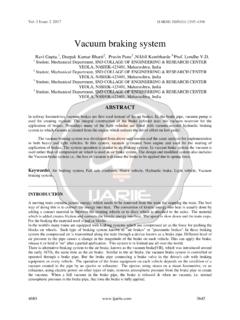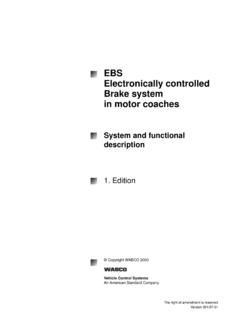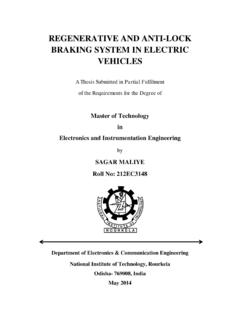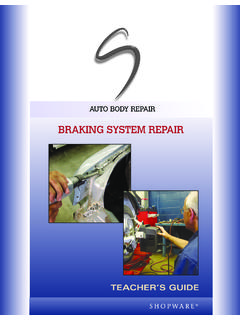Transcription of UNIT 1: INTRODUCTION TO BRAKE SYSTEMS LESSON 1 ...
1 S 5 BRAKESUNIT 1: INTRODUCTION TO BRAKE SYSTEMSLESSON 1: FUNDAMENTAL principles OF BRAKE and fading Loss of brakes, usually due to lining Material mounted on the surface of a BRAKE shoe orpad. BRAKE lining produces a great deal of friction when broughttogether with another friction pads Replaceable friction surfaces that are forced againstthe rotor by the caliper shoe Drum BRAKE component that is forced against abrake drum in order to create A nonrotating disc BRAKE component that forms thecylinder and contains the piston(s) and BRAKE pads. The caliperproduces braking action by using hydraulic pressure to cause aclamping action on a rotating of friction The amount of friction produced by twoobjects rubbing against each brakes BRAKE system that creates friction by forcing brakepads against a rotating brakes BRAKE system that creates friction by forcing brakeshoes against BRAKE energy A type of energy that moves friction A type of friction occurring between two objects,one of which is friction A type of friction occurring between two objects,both of which are 6 AUTOMOTIVE of kinetic energy on the movement of a energy that moves a vehicle is called kinetic energy.
2 A movingvehicle encounters resistance that depletes (takes away) its kineticenergy. Such resistance includes friction created by the vehicle stires rolling against the pavement and by the vehicle s body movingthrough the atmosphere (wind resistance). , wind resistance and tire friction only slow a vehiclegradually. A modern BRAKE system can bring a vehicle to an abruptstop by rapidly converting a vehicle s kinetic energy into heatthrough the use of friction and then dissipating principles of friction involved in BRAKE is the resistance to movement that results from two objectsmoving or rubbing against each other. There are two types offriction: kinetic and friction occurs between two objects, one of which ismoving. Kinetic friction always produces heat. The morekinetic friction produced, the more heat braking SYSTEMS use kinetic friction to convert theenergy of a moving vehicle into friction occurs between two objects that are braking SYSTEMS use static friction to hold a vehiclewhile it is parked.
3 Static friction produces no factors that affect the amount of friction produced betweentwo rougher the surfaces of two objects, the more friction rough surfaces create the most friction, butrough surfaces also wear down quickly. Therefore,automotive brakes use relatively smooth surfaces to avoidrapid order to compensate for their smooth surfaces,automotive brakes are applied with a great amount ofpressure over a relatively large contact greater the pressure bringing the objects together, themore friction they produce. Therefore, the greater thepressure applied to the brakes, with all other factors equal, thegreater their stopping greater the amount of shared contact area between twoobjects, the greater the amount of friction the objects braking SYSTEMS use the largest contact greater the contact area of a BRAKE shoe or pad, theless heat the shoe or pad generates.
4 Less heat allows formore friction, which makes the brakes more : On drum BRAKE SYSTEMS , a BRAKE shoe is appliedto a BRAKE drum to create friction. On disc brakesystems, a BRAKE pad is applied to a disc to createfriction. Both of these SYSTEMS are discussed later in hotter the friction surface of two objects, the less frictionproduced. (Rub your hands together and feel the heat!) heat that the BRAKE system creates must dissipate asrapidly as it is created. The BRAKE system can store littleor no friction surfaces are made of a material that canconduct heat system components that produce friction (brakeshoes or BRAKE pads) are positioned so that air coolsthem. In some braking SYSTEMS , forced air cools amount of friction that two objects produce when rubbingagainst each other is called the coefficient of 8 AUTOMOTIVE important BRAKE friction surface is the BRAKE lining that ismounted on either a BRAKE shoe or BRAKE pad.
5 The BRAKE liningproduces friction by directly contacting another friction surface,either a BRAKE drum or disc. The BRAKE lining and the material thatit touches must have the following special BRAKE drum or disc must conduct heat easily, hold itsshape under extremely high heat, withstand rapid temperaturechanges, resist warping and distortion, and wear well ingeneral. Therefore, BRAKE drums and discs are typicallyconstructed of iron or steel combined with BRAKE lining must be somewhat softer than the BRAKE drumor disc. At present, most BRAKE linings are made of organicmaterials, metallic particles, and other minerals held togetherby a bonding : For years, asbestos was commonly used in brakelinings. Because asbestos is a cancer-causing substance, federallaw prohibits its use in BRAKE the BRAKE lining is applied to a drum or disc, it isimportant that the proper coefficient of friction is produced inorder to ensure that the brakes are the friction coefficient is too great, the brakes may be grabby or overly sensitive.
6 Overly sensitive brakes maycause the vehicle to skid too the friction coefficient is too low, BRAKE applicationrequires excessive pressure. Applying the brakes withexcessive pressure creates excessive heat that could resultin BRAKE : Heat always reduces the coefficient of frictionbetween two objects. Hence, high temperatures maycause brakes to the brakes create more heat than they can dissipate, thefriction coefficient reduces, which causes the brakes tofade. Excessive heat also causes bonding agents in the liningto melt and flow to the surface, which produces a glazeon the shoe 9 BRAKES This glaze reduces the BRAKE s friction coefficient andcauses more BRAKE fading. BRAKE application then requires more pressure, thuscreating more heat and more brakes are applied and how the hydraulic system BRAKE SYSTEMS fall into two major categories: servicebrakes (hydraulic brakes) and parking brakes stop the vehicle when it is in parking BRAKE holds the vehicle while it is parked.
7 Aparking BRAKE is not designed to stop a moving : Parking brakes often use the same friction surfaces asservice BRAKE modern vehicles, hydraulic SYSTEMS transfer pressure(which the driver applies) from the BRAKE pedal to the brakeshoes or pads. In some BRAKE SYSTEMS , servo action and/orpower boosters enhance pressure from the driver s vehicles use two separate hydraulic SYSTEMS to activatethe brakes; therefore, failure of one hydraulic system does notresult in complete BRAKE some vehicles, one hydraulic system activates thefront-wheel brakes while the other hydraulic systemactivates the rear-wheel 10 AUTOMOTIVE other types of vehicles, one hydraulic system activatesthe brakes on one front wheel and one rear wheel whileanother hydraulic system activates the brakes on theother front wheel and rear wheel. In this design, thebrakes on one hydraulic system are always at oppositecorners of the the hydraulic braking system the driver presses the BRAKE pedal, hydraulicpressure builds in the master pressure travels through the BRAKE lines andvalves to various BRAKE activators either the wheelcylinders or wheel cylinders or calipers convert the hydraulicpressure into mechanical drum BRAKE SYSTEMS , hydraulic pressure causes a wheelcylinder to press the BRAKE shoe against the BRAKE disc BRAKE SYSTEMS , hydraulic pressure causes a caliperto press a BRAKE pad against a rotating disc.
8 Therefore, inboth SYSTEMS , the action of one component pressingagainst another creates friction and slows the : Wheel cylinders and calipers are discussed inmore detail later in this the BRAKE releases, various devices move the brakeshoes or BRAKE pads away from the drums or : A cable or some other mechanical linkage notthe hydraulic system activates the parking associated with controlled stopping of the more weight a moving vehicle has, the more kinetic energyit possesses. BRAKE SYSTEMS must convert kinetic energy intoheat; therefore, any increase in vehicle weight puts moredemand on the a vehicle s weight doubles, the amount of kinetic energy thatthe brakes must convert into heat doubles. The amount ofheat energy resulting from the conversion also doubles. Brakeson an overloaded vehicle may therefore become ineffective dueto the speed of a vehicle doubles, the brakes must convertfour times the amount of kinetic energy into heat.
9 Speedgreatly increases the demand on a vehicle s combination of high speed and excessive weight may push avehicle s brakes beyond their performance limit, resulting in aserious loss of stopping between tire and point where a vehicle s tire contacts the road is called thetire footprint. Changes in the tire footprint affect a vehicle sability to stop. Below is a discussion of the factors affectingthe tire larger a tire s diameter is, the larger its footprint is. The larger the tire footprint is, the more stoppingpower can be applied at the tire s contact point with theroad. However, it is important to realize that the greater atire s diameter is, the more braking power is needed tostop the : A general rule is that the larger a tire s diameteris, the more braking power is greater the width of a tire is, the larger the tirefootprint is. The larger the tire footprint is, the more stoppingpower can be applied at the tire s contact point with theroad.
10 However, it is important to realize that the greater atire s width is, the more braking power is needed to stopthe 12 AUTOMOTIVE TECHNOLOGYNOTE: A general rule is that wide tires require vehicle weight can distort tire tread andthereby reduce the tire s hold on the road. Tires thatcannot hold the road reduce the vehicle s ability to vehicle speed can aerodynamically lift a vehicle as itmoves. This lifting reduces the tire s hold on the roadand reduces the vehicle s ability to : Aerodynamic lift merely adds to the stoppingproblems that high speed creates. Remember that everytime a vehicle s speed doubles, the vehicle s requiredstopping power quadruples, even if there is noaerodynamic : To control the vehicle, friction must occur at thetire footprint. If this friction is lost, the vehicle is out grip the road more securely and can stop better ifthe wheels are moving. Therefore, the stopping powerdecreases if the brakes lock up the wheels.









